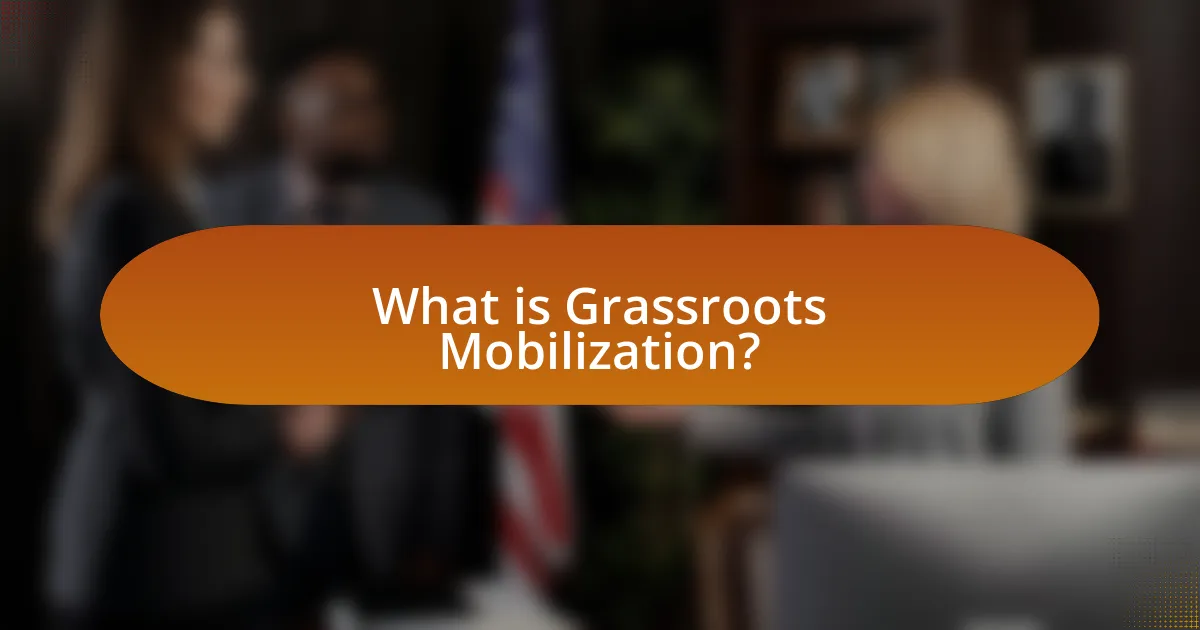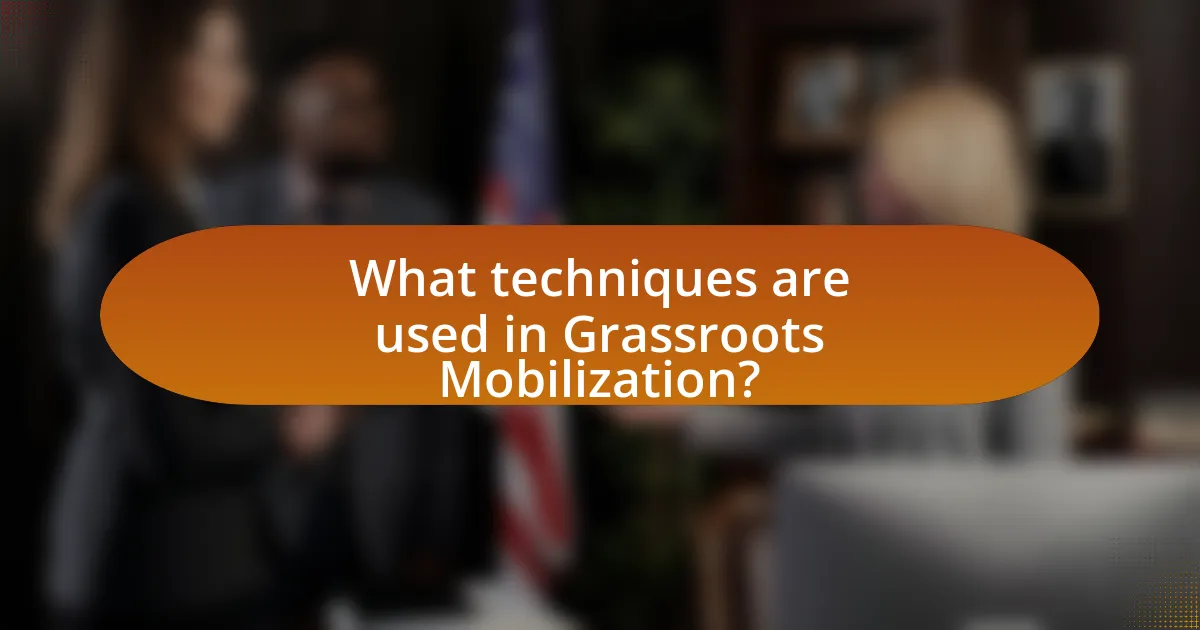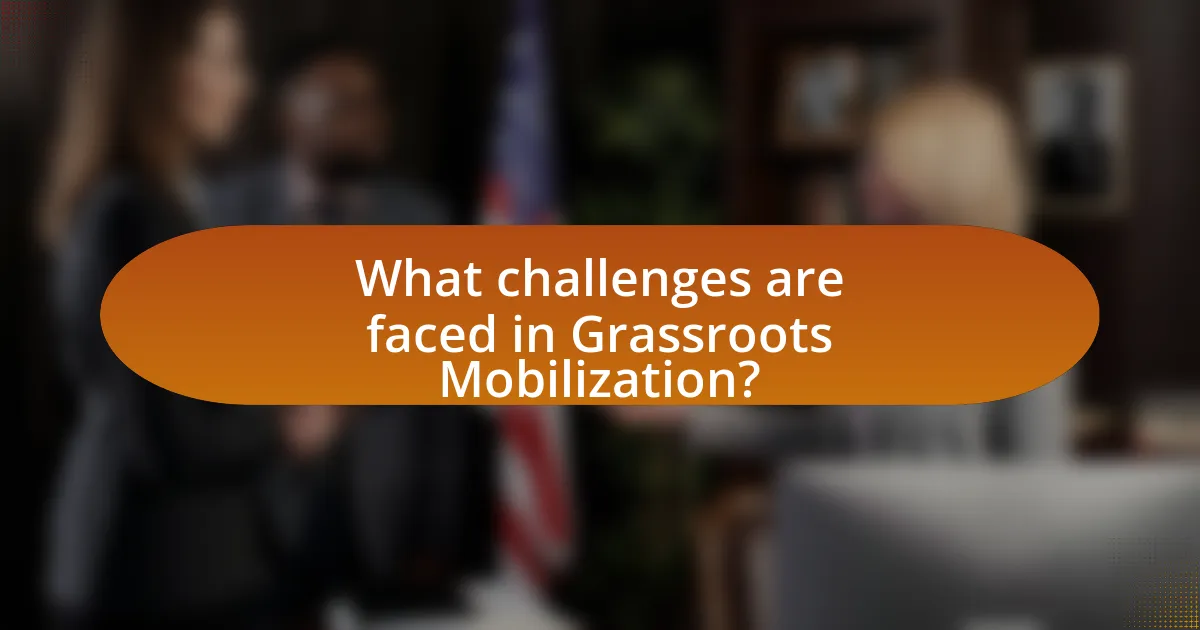Grassroots mobilization is the process of engaging and organizing individuals at the community level to advocate for social, political, or environmental change. This article explores the functions, key elements, and techniques of grassroots mobilization, emphasizing its importance for community engagement and decision-making. It discusses how community needs shape mobilization strategies, the role of social media, and the impact of community leaders. Additionally, the article addresses challenges faced in grassroots efforts, strategies to overcome opposition, and best practices for enhancing inclusivity and engagement. Through examining these aspects, the article highlights the significance of grassroots mobilization in empowering marginalized groups and driving local change.

What is Grassroots Mobilization?
Grassroots mobilization is the process of engaging and organizing individuals at the community level to advocate for social, political, or environmental change. This approach relies on the collective action of local citizens who come together to address issues that affect their lives, often utilizing strategies such as community meetings, social media campaigns, and door-to-door outreach. Evidence of its effectiveness can be seen in movements like the Civil Rights Movement in the United States, where grassroots efforts played a crucial role in achieving significant legislative changes.
How does Grassroots Mobilization function in local communities?
Grassroots mobilization functions in local communities by empowering individuals to organize and advocate for collective action on issues that affect them. This process typically involves community members identifying shared concerns, forming groups, and utilizing strategies such as door-to-door outreach, social media campaigns, and public meetings to raise awareness and build support. For instance, studies have shown that grassroots movements can effectively influence local policy changes, as seen in the successful campaigns for environmental regulations in various cities, where community engagement led to significant legislative outcomes.
What are the key elements of effective Grassroots Mobilization?
The key elements of effective grassroots mobilization include community engagement, clear messaging, leadership development, and strategic partnerships. Community engagement fosters trust and participation, as seen in successful campaigns like the 2008 Obama campaign, which utilized local volunteers to connect with voters. Clear messaging ensures that the goals and values resonate with the target audience, exemplified by movements like Black Lives Matter, which effectively communicated their mission. Leadership development empowers individuals within the community to take initiative, creating a sustainable movement. Strategic partnerships with local organizations amplify reach and resources, as demonstrated by various environmental campaigns that collaborate with local NGOs to enhance impact.
How do community needs influence Grassroots Mobilization strategies?
Community needs significantly influence grassroots mobilization strategies by shaping the focus and methods of engagement. When grassroots organizations assess the specific needs of a community, they tailor their strategies to address those needs effectively, ensuring that their initiatives resonate with local residents. For instance, if a community identifies a lack of access to healthcare, mobilization efforts may prioritize health education campaigns or the establishment of local clinics. Research indicates that successful grassroots movements often arise from a clear understanding of community priorities, as seen in the case of the Civil Rights Movement, where local leaders mobilized around the pressing need for racial equality and justice. This alignment between community needs and mobilization strategies enhances participation and fosters a sense of ownership among community members, ultimately leading to more sustainable outcomes.
Why is Grassroots Mobilization important for community engagement?
Grassroots mobilization is important for community engagement because it empowers individuals at the local level to take collective action on issues that affect their lives. This approach fosters a sense of ownership and responsibility among community members, leading to increased participation in decision-making processes. Research indicates that communities that engage in grassroots mobilization often experience improved social cohesion and enhanced capacity to address local challenges, as seen in various successful initiatives across the globe. For example, the community-led movements in the United States during the civil rights era demonstrated how grassroots efforts can effectively mobilize support and drive significant social change.
What impact does Grassroots Mobilization have on local decision-making?
Grassroots mobilization significantly influences local decision-making by empowering community members to actively participate in the political process. This engagement often leads to increased accountability among local officials, as elected representatives become more responsive to the needs and concerns of their constituents. For instance, studies have shown that communities that organize grassroots campaigns can effectively sway local policies, as seen in the successful advocacy for environmental regulations in various municipalities, where citizen-led initiatives prompted local governments to adopt more sustainable practices. This demonstrates that grassroots mobilization not only amplifies community voices but also drives tangible changes in local governance.
How does Grassroots Mobilization empower marginalized groups?
Grassroots mobilization empowers marginalized groups by providing them with a platform to voice their concerns and advocate for their rights. This process fosters community engagement, enabling individuals to organize collectively and influence decision-making processes that affect their lives. For instance, studies have shown that grassroots movements, such as the Civil Rights Movement in the United States, successfully mobilized marginalized communities to challenge systemic injustices and achieve significant legislative changes, like the Voting Rights Act of 1965. By facilitating access to resources, information, and networks, grassroots mobilization enhances the political agency of marginalized groups, allowing them to effect change in their communities.

What techniques are used in Grassroots Mobilization?
Grassroots mobilization employs techniques such as community organizing, social media engagement, door-to-door canvassing, and coalition building. Community organizing involves identifying local leaders and fostering relationships to empower individuals to advocate for their needs. Social media engagement utilizes platforms to spread awareness and mobilize supporters quickly, as evidenced by movements like the Arab Spring, where social media played a crucial role in organizing protests. Door-to-door canvassing allows for direct interaction with community members, facilitating personal connections and gathering support. Coalition building brings together various organizations and stakeholders to amplify efforts and resources, enhancing the overall impact of grassroots initiatives.
How can social media enhance Grassroots Mobilization efforts?
Social media enhances grassroots mobilization efforts by providing a platform for rapid communication and community engagement. It allows organizations to disseminate information quickly, mobilize supporters, and coordinate actions effectively. For instance, during the Arab Spring, social media played a crucial role in organizing protests and spreading awareness, demonstrating its power in grassroots movements. Additionally, studies show that social media can increase participation rates; a report by the Pew Research Center found that 69% of adults in the U.S. use social media, which can be leveraged to reach diverse demographics and foster community involvement.
What platforms are most effective for Grassroots Mobilization?
Social media platforms, particularly Facebook, Twitter, and Instagram, are the most effective for grassroots mobilization. These platforms enable rapid information dissemination, community engagement, and mobilization efforts through features like event creation, sharing capabilities, and targeted advertising. For instance, a study by the Pew Research Center found that 69% of adults in the U.S. use Facebook, making it a powerful tool for organizing and rallying support for local causes. Additionally, Twitter’s real-time communication allows for immediate updates and engagement, while Instagram’s visual content can effectively capture attention and inspire action.
How can storytelling be utilized in Grassroots Mobilization campaigns?
Storytelling can be utilized in grassroots mobilization campaigns by creating emotional connections that inspire action and foster community engagement. Effective narratives highlight personal experiences and shared values, making complex issues relatable and motivating individuals to participate. For instance, campaigns that share stories of local individuals affected by specific issues can humanize the cause, leading to increased empathy and support. Research shows that narratives can enhance message retention and influence attitudes, as evidenced by a study published in the Journal of Communication, which found that stories significantly improve persuasion compared to statistics alone. This demonstrates that storytelling is a powerful tool in mobilizing grassroots efforts by transforming abstract concepts into compelling, actionable narratives.
What role do community leaders play in Grassroots Mobilization?
Community leaders play a crucial role in grassroots mobilization by serving as trusted figures who can effectively organize and inspire local populations. They facilitate communication between community members and external organizations, ensuring that the voices of the community are heard and represented. Research indicates that grassroots movements led by community leaders are more successful in achieving their goals, as these leaders possess a deep understanding of local issues and can mobilize resources effectively. For instance, studies show that community-led initiatives often result in higher participation rates and more sustainable outcomes, as leaders leverage their networks and influence to engage residents actively.
How can leaders effectively inspire and mobilize community members?
Leaders can effectively inspire and mobilize community members by fostering a shared vision and actively engaging individuals in the decision-making process. This approach encourages ownership and commitment among community members, leading to increased participation. Research indicates that when leaders communicate a clear and compelling vision, such as through storytelling or relatable examples, it resonates more deeply with individuals, motivating them to take action. For instance, a study by the Stanford Social Innovation Review highlights that leaders who involve community members in collaborative projects see a 30% increase in volunteer participation compared to those who do not. By creating inclusive environments where community voices are heard and valued, leaders can build trust and drive collective action.
What skills are essential for leaders in Grassroots Mobilization?
Essential skills for leaders in grassroots mobilization include effective communication, community engagement, and strategic planning. Effective communication allows leaders to articulate their vision and mobilize support, as evidenced by successful campaigns that rely on clear messaging to resonate with diverse audiences. Community engagement skills enable leaders to build trust and foster relationships within the community, which is crucial for mobilizing grassroots efforts; studies show that initiatives with strong community ties are more likely to succeed. Strategic planning skills help leaders to set achievable goals and develop actionable plans, ensuring that mobilization efforts are organized and focused, as demonstrated by various grassroots movements that have achieved significant impact through well-structured strategies.

What challenges are faced in Grassroots Mobilization?
Grassroots mobilization faces several challenges, including limited resources, lack of awareness, and resistance from established institutions. Limited resources hinder the ability to effectively organize and sustain campaigns, as funding and volunteer support are often scarce. Lack of awareness among community members can prevent engagement, as individuals may not understand the issues at stake or the importance of their participation. Additionally, resistance from established institutions, such as local governments or corporations, can create obstacles by undermining efforts or creating barriers to mobilization. These challenges are well-documented in studies on community organizing, highlighting the complexities involved in mobilizing grassroots efforts effectively.
How can resistance from local authorities impact Grassroots Mobilization?
Resistance from local authorities can significantly hinder grassroots mobilization by creating barriers to access, limiting resources, and stifling community engagement. When local authorities oppose grassroots initiatives, they may impose regulations that restrict public gatherings, deny permits for events, or allocate funding away from community-driven projects. For instance, a study by the National Civic League found that communities facing opposition from local governments often experience a decrease in participation rates, as residents feel discouraged or fearful of repercussions. This resistance can lead to fragmentation within the community, reducing the effectiveness of mobilization efforts and ultimately undermining the goals of grassroots movements.
What strategies can be employed to overcome opposition?
To overcome opposition in grassroots mobilization, strategies such as building coalitions, engaging in active listening, and utilizing effective communication can be employed. Building coalitions involves forming alliances with like-minded organizations and individuals to strengthen the movement’s influence and resources. Engaging in active listening allows leaders to understand the concerns of opponents, which can help in addressing misconceptions and finding common ground. Effective communication, including clear messaging and storytelling, can resonate with the community and counteract negative narratives. Research indicates that movements that effectively engage their audience and address opposition through dialogue are more successful in achieving their goals, as seen in various social movements throughout history.
How can Grassroots Mobilization adapt to changing political climates?
Grassroots mobilization can adapt to changing political climates by employing flexible strategies that respond to the evolving needs and sentiments of the community. This adaptability includes utilizing social media platforms for real-time communication, which allows grassroots organizations to quickly disseminate information and mobilize supporters in response to political shifts. For instance, during the 2020 U.S. elections, grassroots movements effectively leveraged platforms like Twitter and Facebook to organize protests and campaigns, demonstrating their ability to pivot strategies based on the political landscape. Additionally, grassroots mobilization can incorporate diverse coalition-building efforts, engaging various community stakeholders to create a unified front that addresses specific local issues, thereby enhancing resilience against political changes.
What are common pitfalls in Grassroots Mobilization efforts?
Common pitfalls in grassroots mobilization efforts include lack of clear goals, insufficient community engagement, and failure to build sustainable relationships. Without clear goals, mobilization efforts can become unfocused, leading to wasted resources and diminished impact. Insufficient community engagement often results in a disconnect between organizers and the community, causing mistrust and reduced participation. Additionally, failing to build sustainable relationships can lead to short-lived initiatives that do not foster long-term change or community empowerment. These pitfalls are supported by research indicating that effective grassroots movements require clarity, trust, and ongoing collaboration to succeed.
How can organizations avoid burnout among volunteers?
Organizations can avoid burnout among volunteers by implementing clear communication, setting realistic expectations, and providing adequate support. Clear communication ensures that volunteers understand their roles and responsibilities, reducing confusion and stress. Setting realistic expectations helps prevent overwhelming volunteers with excessive tasks, which can lead to fatigue. Providing adequate support, such as training and resources, empowers volunteers and fosters a positive environment. Research indicates that organizations with structured volunteer management practices experience lower turnover rates and higher volunteer satisfaction, demonstrating the effectiveness of these strategies in preventing burnout.
What measures can be taken to ensure inclusivity in Grassroots Mobilization?
To ensure inclusivity in grassroots mobilization, organizations should implement targeted outreach strategies that engage diverse community members. This can include conducting surveys to identify underrepresented groups, organizing community forums that encourage participation from various demographics, and providing materials in multiple languages to accommodate non-native speakers. Research indicates that inclusive practices lead to higher community engagement; for instance, a study by the National Civic League found that inclusive outreach efforts can increase participation rates by up to 30%. By actively seeking input from marginalized populations and adapting communication methods, grassroots initiatives can foster a more equitable and representative mobilization process.
What best practices can enhance Grassroots Mobilization initiatives?
Effective grassroots mobilization initiatives can be enhanced by fostering community engagement, utilizing social media, and building strong coalitions. Engaging the community involves actively listening to their needs and incorporating their feedback into initiatives, which increases ownership and participation. Social media platforms serve as powerful tools for outreach, allowing for rapid dissemination of information and mobilization of supporters. Building coalitions with local organizations amplifies resources and networks, creating a more robust support system for initiatives. Research indicates that grassroots movements that effectively engage their communities and leverage technology can achieve higher levels of participation and impact, as seen in successful campaigns like the Women’s March in 2017, which utilized social media to mobilize millions globally.
How can effective communication strategies improve engagement?
Effective communication strategies enhance engagement by fostering clarity, building trust, and encouraging participation among community members. When communication is clear and tailored to the audience, individuals are more likely to understand the goals and objectives of grassroots initiatives, leading to increased involvement. Research indicates that organizations employing effective communication techniques, such as active listening and feedback mechanisms, experience higher levels of community participation. For instance, a study by the International Association for Public Participation found that projects with strong communication frameworks saw a 40% increase in community engagement compared to those with less effective communication. This demonstrates that strategic communication not only informs but also empowers individuals, ultimately driving greater engagement in local initiatives.
What role does feedback play in refining Grassroots Mobilization efforts?
Feedback is crucial in refining grassroots mobilization efforts as it provides insights into community needs and perceptions. By actively soliciting and analyzing feedback from community members, organizers can identify strengths and weaknesses in their strategies, allowing for adjustments that enhance engagement and effectiveness. For instance, a study by the Stanford Social Innovation Review highlights that organizations that incorporate participant feedback into their programs see a 30% increase in community involvement. This demonstrates that feedback not only informs but also strengthens grassroots initiatives by ensuring they are responsive and relevant to the community’s evolving dynamics.

